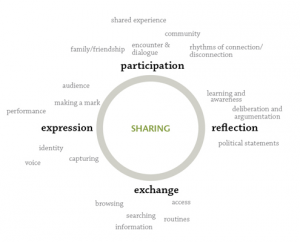12. March 2011
Introduction
Urban spaces are constantly growing whereas the countryside begins to dry out and is more used as a place to spend the free time. The phenomen that comes with this evolutionary space setting is that the more people live in a certain amount of space the more increases the anonymity between the individuals. Through the incredibly possibilities of the new and emerging communication technologies we connect with friends from all over the world – anytime. We put the world as a village. We communicate with our friends incessantly and the density and intensity of this interchangement is overwhelming. We write statuses about personal live we make comments about politics, lifestyle, trends, economy and much more instantly. We share artefacts like photos, videos, music we know where our friends are and we know even where we find a store, a restaurant etc. nearby. We participate in our friends live like never before. But what happens in real life with people around us? Why do we know so little about each other and interconnect much less with them than we do with our friends online? We're sitting next to human beeings in a train and are socializing in a digital way with friends. Is Technology here a disabling media? Does digital mobile social media inhibit us to socialize to outer space? Compared to the high concentration of our friends-communication we find a kind of vacuum in the sense of interaction with unknown people around us. There are reasons for this lack of communication. Some of them we already know from existing studies. [list] My personal belief is that we don't use the full potential of the intellectual and emotional power around us and I'm deeply interested to address this situation in my MA-thesis. I would like to find and sketch the social-contexts we all live in and which all are very personal but at the same time highly connected to others. One's social context changes over time, during a day and potentially more during lifetime. During an ordinary day we change location, feelings, interests...everything is supposed to change. One day we pass a placard without noticing it but already the next day it might make us smiling. So, finally when and why we are stimulated to connect us with somebody else is very personal. There are criterias we identify to describe positive or negative influences to connect to strangers at specific locations. These influences give key aspects of how a communication-enabling-solution should be constructed to be used as a framework or media delivered to participants (social context framework). This framework is an enabling base but even more important to get the full picture we have to understand one's personal situation at a specific time and location. Somebody must be internally "ready" to connect with it's outer space. One approach I see lays in finding this personal readyness and as soon it's found to support or initiate a communication-process. Another way would be to record past changes and give a person a tool to visit those lost moments whenever the person is willing to do it. So, what I see that is needed is in the first place the social context framework and second the individual's footprints which can be seen as dynamic data flowing and interchanging in the framework. It will be a part of my research work to find social-contexts and investigate in how to enable the participation in the intellectual and emotional power around us. Starting from existing studies and own additional observations about communication-enablers/disablers I would like to extract requirements for a mobile application and/or other artefacts. It's needed to develop soon a first prototype to test the implemented feature/behaviour against and in the real world context. Finally the goal of the project is to enable interaction between strangers considering the digital social footprint. Therefore the quality of the composition of the interaction (next to the functionality) plays an important role.Social (digital) foot prints
As soon as we interact we somebody else we share something. We share thoughts, experiences, emotions and so on. An interesting hint what a social context is about is the question: What do we share? I found an interesting view on what we share in a design research project of Nassim Jafarinaimi. Nassim Jafarinaimi is a Visiting Assistant Professor at the School of Literature, Communication, and Culture (LCC) at Georgia Institute of Technology and he is also a PhD candidate in the School of Design at Carnegie Mellon University (CMU).
There are some more aspects beside the WHAT (we share) I would like to introduce. Here as a list:
Nassim Jafarinaimi is a Visiting Assistant Professor at the School of Literature, Communication, and Culture (LCC) at Georgia Institute of Technology and he is also a PhD candidate in the School of Design at Carnegie Mellon University (CMU).
There are some more aspects beside the WHAT (we share) I would like to introduce. Here as a list:
- WHAT: participation, expression, exchange, reflection
- WHEN: time, situation, personal feelings
- WHERE: location (as coordinates or personal spaces)
- HOW or HOW DEEP:
- WHY : enabler/ disabler of communication
- with WHOM:
